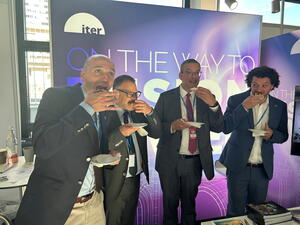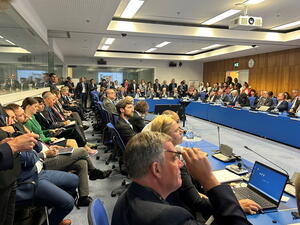Growing interest in fusion energy
The torus of a tokamak is often described as “donut-shaped.” And although it had been quite some time since ITER last offered tokamak donuts to participants at a conference, we learned earlier this month that they still prove to be a highlight. Even with the delicious competition served up at the 69th General Conference of the International Atomic Energy Agency (IAEA) in Vienna, with delegates from more than 130 countries and many international organizations participating, the ITER exhibition drew consistent attention all week.
The IAEA has been closely involved in the development of the ITER project since its genesis. Early cooperation and negotiation phases took place under the auspices of the IAEA, and even today the Director General of the IAEA remains the depositary of the ITER Agreement. This strong bond becomes especially apparent once per year.
The annual IAEA General Conference with its thousands of participants is a huge stage for high-ranking officials and representatives from IAEA Member States to meet and discuss a wide range of nuclear technologies, applications and policies. During the five-day event each head of delegation has the chance to address the plenary session. Representing ITER, Director-General Pietro Barabaschi gave a recorded speech (read the transcript here), during which he summarized the unprecedented progress made since project re-baselining in 2024 as “ITER’s strongest performance to date.”
The growing interest in fusion energy called for a special side event this year focusing on the regulatory framework for fusion facilities. The conference room was packed, with standing room only—the large number of attendees and the enthusiastic Q&A session proving that this is a topic of interest to the community. The French Authority for Nuclear Safety and Radiation Protection (ASNR), the ITER Organization, the European Commission and the German Government shared their experience with the safety demonstration strategy adopted by ITER before discussions turned to the future. What will the requirements be for a large, commercial fusion facility?
Above all, the IAEA General Conference is always a superb location for networking and interacting. ITER Director-General Barabaschi used the occasion to meet with the IAEA Director General Rafael Grossi, the US Secretary of Energy, the Secretary of the Indian Department of Atomic Energy, the Korean Vice-Minister of Science and ICT, and other governmental and inter-governmental leaders.
Fusion energy is increasingly a topic of interest and discussion across the public and private sectors. The IAEA’s presence as a recognized leader in establishing international standards and providing a forum for discussion remains an asset for all.



